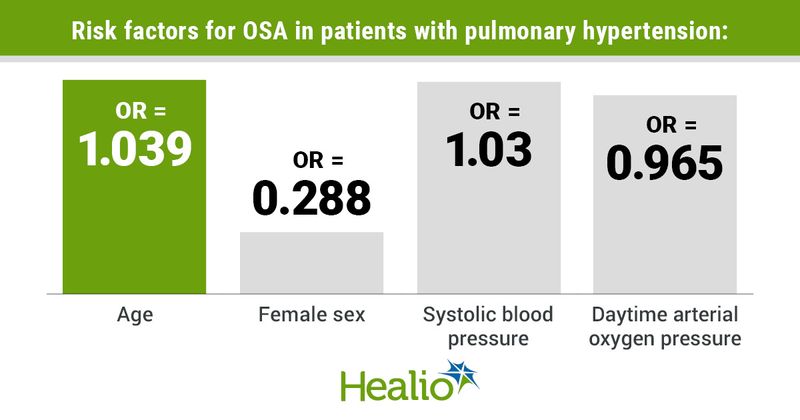Obstructive sleep apnea common in pulmonary hypertension
Click Here to Manage Email Alerts
In a new study, researchers reported obstructive sleep apnea is common in patients with pulmonary hypertension, and risk factors include older age, male sex and lower daytime arterial oxygen pressure.
This single-center, observational study enrolled 140 patients with pulmonary hypertension (mean age, 39.5 years; 76.4% women) diagnosed via right heart catheterization who underwent overnight cardiorespiratory monitoring from December 2018 to December 2020. OSA was defined by an apnea-hypopnea index of 5 or more hours with 50% or more obstructive apneic events. Researchers then compared patients with pulmonary hypertension with and without OSA.

Twenty-five percent of patients with pulmonary hypertension had OSA. The incidence of OSA was 76% among patients with pulmonary hypertension associated with pulmonary disease or low oxygen, 50% among those with chronic thromboembolic pulmonary hypertension, 15.4% among those with connective tissue disease-associated PAH, 11.8% among those with unknown mechanisms of pulmonary hypertension and 8% among those with congenital heart disease-associated PAH.
Most patients with OSA were men (42.9% vs. 17.1%; P = .001), older (46.7 years vs. 37 years; P = .001) and had lower daytime arterial oxygen pressure (63.69 mm Hg vs. 71.77 mm Hg; P = .014) compared with patients without OSA.
Age (OR = 1.039; 95% CI, 1.005-1.975; P = .025), female sex (OR = 0.288; 95% CI, 0.112-0.738; P = .01), systolic blood pressure (OR = 1.03; 95% CI, 0.998-1.064; P = .068) and daytime arterial oxygen pressure (OR = 0.965; 95% CI, 0.931-1; P = .049) were associated with OSA among patients with pulmonary hypertension in a multivariate logistic regression analysis after correction for BMI, according to the results.
In addition, older age, male sex and lower daytime arterial oxygen pressure had the strongest ability to indicate OSA in this patient population, the researchers wrote.
“OSA has a high incidence in patients with pulmonary hypertension. OSA may aggravate pulmonary hypertension to some extent, and advanced age, male sex and lower daytime PaO2 could predict the presence of OSA. It may be important to identify and treat pulmonary hypertension patients with OSA,” Lu Yan, MD, from the Center for Pulmonary Vascular Diseases, Fuwai Hospital, National Center for Cardiovascular Diseases, Chinese Academy of Medical Sciences and Peking Union Medical College, Beijing, and colleagues wrote in BMC Pulmonary Medicine. “The clinical significance of pulmonary hypertension with OSA requires further investigation.”
